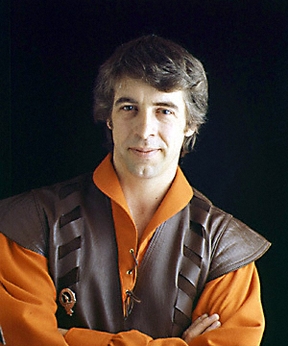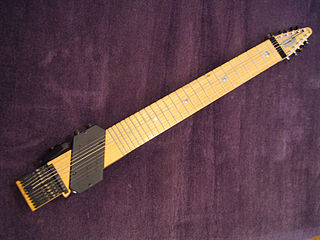
A mandolin is a stringed musical instrument in the lute family and is generally plucked with a pick. It most commonly has four courses of doubled strings tuned in unison, thus giving a total of eight strings. A variety of string types are used, with steel strings being the most common and usually the least expensive. The courses are typically tuned in an interval of perfect fifths, with the same tuning as a violin. Also, like the violin, it is the soprano member of a family that includes the mandola, octave mandolin, mandocello and mandobass.

In musical instrument classification, string instruments or chordophones, are musical instruments that produce sound from vibrating strings when a performer plays or sounds the strings in some manner.

A guitar pick is a plectrum used for guitars. Picks are generally made of one uniform material, such as some kind of plastic, rubber, felt, tortoiseshell, wood, metal, glass, tagua, thermosetting plastic or stone. They are often shaped in an acute isosceles triangle with the two equal corners rounded and the third corner less rounded. They are used to strum chords or to sound individual notes on a guitar.
The Corries were a Scottish folk group that emerged from the Scottish folk revival of the early 1960s. The group was a trio from their formation until 1966 when founder Bill Smith left the band but Roy Williamson and Ronnie Browne continued as a duo until Williamson's death in 1990.

Roy Murdoch Buchanan Williamson was a Scottish songwriter and folk musician, most notably with The Corries. Williamson is best known for writing "Flower of Scotland", which has become the de facto national anthem of Scotland used at international sporting events.

Ronald Grant Browne is a Scottish folk musician and songwriter, who is a founding member of The Corries.

The bandurria is a plucked chordophone from Spain, similar to the mandolin and bandola, primarily used in Spanish folk music, but also found in former Spanish colonies.

A course, on a stringed musical instrument, is either one string or two or more adjacent strings that are closely spaced relative to the other strings, and typically played as a single string. The strings in each multiple-string course are typically tuned in unison or an octave.

Peat Fire Flame is an album recorded in 1977 by The Corries, a Scottish folk group. The combolin is heard to advantage on "Come By the Hills". Williamson and Ronnie Browne are heard on the vocals. There is multi-tracking to include both men on guitars, Northumbrian pipes, harmonicas, whistles, flutes, concertina, mandolins, boranns, fiddle and combolins. The last four tracks are designed to be heard as one continuous track. Running time: 38 minutes 13 seconds.

Released in 1980, Stovies is the eighteenth album by The Corries. Recorded at one or more live concerts, most of the songs have spoken introductions. As well as two Jacobite folk songs written by the band, the release includes a tribute to Rob Roy.

A multi-neck guitar is a guitar that has multiple fingerboard necks. They exist in both electric and acoustic versions. Examples of multi-neck guitars and lutes go back at least to the Renaissance.
A solid-body musical instrument is a string instrument such as a guitar, bass or violin built without its normal sound box and relying on an electromagnetic pickup system to directly detect the vibrations of the strings; these instruments are usually plugged into an instrument amplifier and loudspeaker to be heard. Solid-body instruments are preferred in situations where acoustic feedback may otherwise be a problem and are inherently both less expensive to build and more rugged than acoustic electric instruments.

The Corrie Folk Trio and Paddie Bell is the eponymous 1964 album by The Corrie Folk Trio and Paddie Bell.

The Promise of the Day is a music album by the band The Corrie Folk Trio and Paddie Bell. The album was produced in 1965 for the Scottish label Waverley Records. It was issued by the American label Elektra Records in 1966.

The mandore is a musical instrument, a small member of the lute family, teardrop shaped, with four to six courses of gut strings and pitched in the treble range. Considered a French instrument, with much of the surviving music coming from France, it was used across "Northern Europe" including Germany and Scotland. Although it went out of style, the French instrument has been revived for use in classical music. The instrument's most commonly played relatives today are members of the mandolin family and the bandurria.

Kalk Samen Kuri no Hana, also known as Kalk Samen Chestnut Flower and Chlorine Semen Chestnut Flower, is the third studio album by Japanese singer-songwriter Ringo Sheena, released on February 23, 2003, on Toshiba EMI / Virgin Music. The album's lead single was a massive success, topping the Oricon charts for the first time in her career.

Experimental luthiers are luthiers who take part in alternative stringed instrument manufacturing or create original string instruments altogether.
In music, a chop chord is a "clipped backbeat". In 4
4: 1 2 3 4. It is a muted chord that marks the off-beats or upbeats. As a rhythm guitar and mandolin technique, it is accomplished through chucking, in which the chord is muted by lifting the fretting fingers immediately after strumming, producing a percussive effect.
The chop is analogous to a snare drum beat and keeps the rhythm together and moving. It's one of the innovations bluegrass inventor Bill Monroe pioneered, and it gave the music a harder groove and separated it from old-time and mountain music.

Live from Scotland Volume 1 was a 1974 album by The Corries recorded at the Glasgow City Halls.

Live from Scotland Volume 2 was a 1975 album by The Corries recorded at the Glasgow City Halls, Motherwell Town Hall, Dunfermline Carnegie Hall and Edinburgh Usher Hall, in 1974 and 1975.















